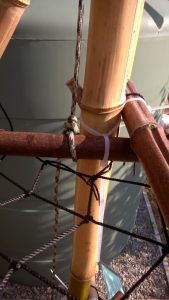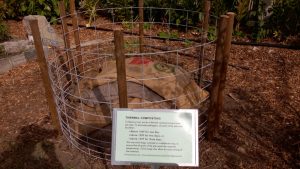Compost-Drying Rack
installed 08/18/2018
signage:
Drying slows down decomposition because the microbial decomposers need water to survive. Drying also helps retain the maximum amount of nitrogen available when making compost. We make compost out of:
NITROGEN: Carbon to Nitrogen ratios range from 10:1 to 30:1) green plant material, beer mash, germs of seeds, coffee grounds, rabbit feces.
CARBON: (Carbon to Nitrogen ratios range 100:1) Wood chips, dead plant leaves, cardboard, paper, dryer lint
The advantage of building the roof next to the cistern rather than over it is that now we finally have a drying rack for future compost materials. We can also keep our straw dry under the new roof. The drying rack is made of bamboo also. (Seattle residents grow bamboo and it inevitably gets out of control. They are delighted when we pick it up and we use it for signs, trellis and other structures.)
This drying rack sits under the roof (see photo on New Cistern and Water Catchment Roof page) and is held together with zip ties. They interlock around the bamboo pieces, the same as you would build with hose clamps; one is tied around one piece of bamboo and then the other slides through that tie and ties around the second piece of bamboo.
I added a diagonal piece of bamboo horizontally under each shelf, so that the webbing does not sag from the weight of the wet compost materials. Then I added a couple of longer diagonal pieces to the corner posts so the rack would not twist.
The webbing is nylon knotted cargo webbing, which would be the same as using an old soccer net.

Since bamboo is a little slippery, I attached one length of nylon cord to the top of each corner post of the rack. That cord runs vertically. At the desired level of each shelf, I tied a bowline knot to secure a horizontal piece of bamboo of that shelf, then ran the cord down to the next shelf and added another bowline and then continued down the rack so each shelf would stay in place.
Thermal Composting
signage:
To feed our soil, we do a thermal compost process twice per year. To eliminate pathogens, all parts of the pile must be either:
- Above 165F for one day.
- Above 150F for two days
- Above 135F for three days
We use onion bags, oriented in a deliberate way, to ensure that all parts of the pile reach the required temperatures. Onion bags also allow for easy turning of the materials
We feel that good compost is the basis of a good garden and we make our own thermal compost twice per year. Compost is an essential component of the overall watering plan since it can hold 10 times its weight in water. There are areas within the orchard where the soil is sandy. In those places, we are generous with compost to try to hold the water and nutrients don’t slip past the root zone when we water.

